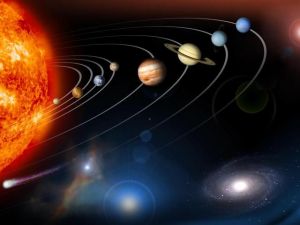Difference between revisions of "Star system"
m (category creation for Star System) |
|||
| Line 1: | Line 1: | ||
| − | + | [[File:Solar system.jpg|thumb|right|Sector 001's solar system]] | |
| + | |||
| + | ''For the star system in which the planet [[Earth]] is located, see [[Sol System]].'' | ||
| + | |||
| + | |||
| + | A '''star system''' or '''solar system''' is the area around a [[star]] (or a group of stars) which contains all of the [[planet]]s, [[moon]]s, [[asteroid]]s, [[nebula]]e and other landmarks which are held in place by the star's [[gravity well]]. | ||
| + | |||
| + | |||
| + | A Solar system's boundaries are usually marked by the area in which a star or celestial body's gravitational force affects its surrounding environment. <br> Often the edge of these boundaries is a large, thin layer of ice, dust and debris called an [https://solarsystem.nasa.gov/solar-system/oort-cloud/overview/#:~:text=The%20Oort%20Cloud%20is%20a,in%20the%20Oort%20Cloud%20itself. Oort cloud]. (''Source: NASA'') | ||
| + | |||
| + | |||
| + | The planets and other bodies in a solar system [[orbit]] the star (or stars) at different distances; these distances can be classified into three distinct "zones": | ||
| + | * (1) the '''hot''' zone, which is closest to the star, produces temperatures prohibitive of life, such as on [[Mercury (planet)|Mercury]] | ||
| + | * (2) the '''ecosphere''' zone, where life can find a foothold and flourish, given the balance between solar [[energy]] received and [[radiation|radiated]], such as [[Earth]], [[Vulcan]], and [[Bajor]] | ||
| + | * (3) the '''cold zone''', which lies farthest from the star and receives the least energy; [[Pluto]] orbits in the cold zone, where Sol appears merely as another bright star. | ||
| + | |||
| + | |||
| + | Using [[warp drive]] to travel from within a solar system to another point in the system is not recommended. | ||
| + | |||
| − | |||
| − | |||
| − | |||
| − | |||
| − | |||
| − | |||
| − | |||
| − | |||
[[Category:Star System]] | [[Category:Star System]] | ||
| − | + | [[category:science]] | |
Latest revision as of 13:41, 2 September 2021
For the star system in which the planet Earth is located, see Sol System.
A star system or solar system is the area around a star (or a group of stars) which contains all of the planets, moons, asteroids, nebulae and other landmarks which are held in place by the star's gravity well.
A Solar system's boundaries are usually marked by the area in which a star or celestial body's gravitational force affects its surrounding environment.
Often the edge of these boundaries is a large, thin layer of ice, dust and debris called an Oort cloud. (Source: NASA)
The planets and other bodies in a solar system orbit the star (or stars) at different distances; these distances can be classified into three distinct "zones":
- (1) the hot zone, which is closest to the star, produces temperatures prohibitive of life, such as on Mercury
- (2) the ecosphere zone, where life can find a foothold and flourish, given the balance between solar energy received and radiated, such as Earth, Vulcan, and Bajor
- (3) the cold zone, which lies farthest from the star and receives the least energy; Pluto orbits in the cold zone, where Sol appears merely as another bright star.
Using warp drive to travel from within a solar system to another point in the system is not recommended.
